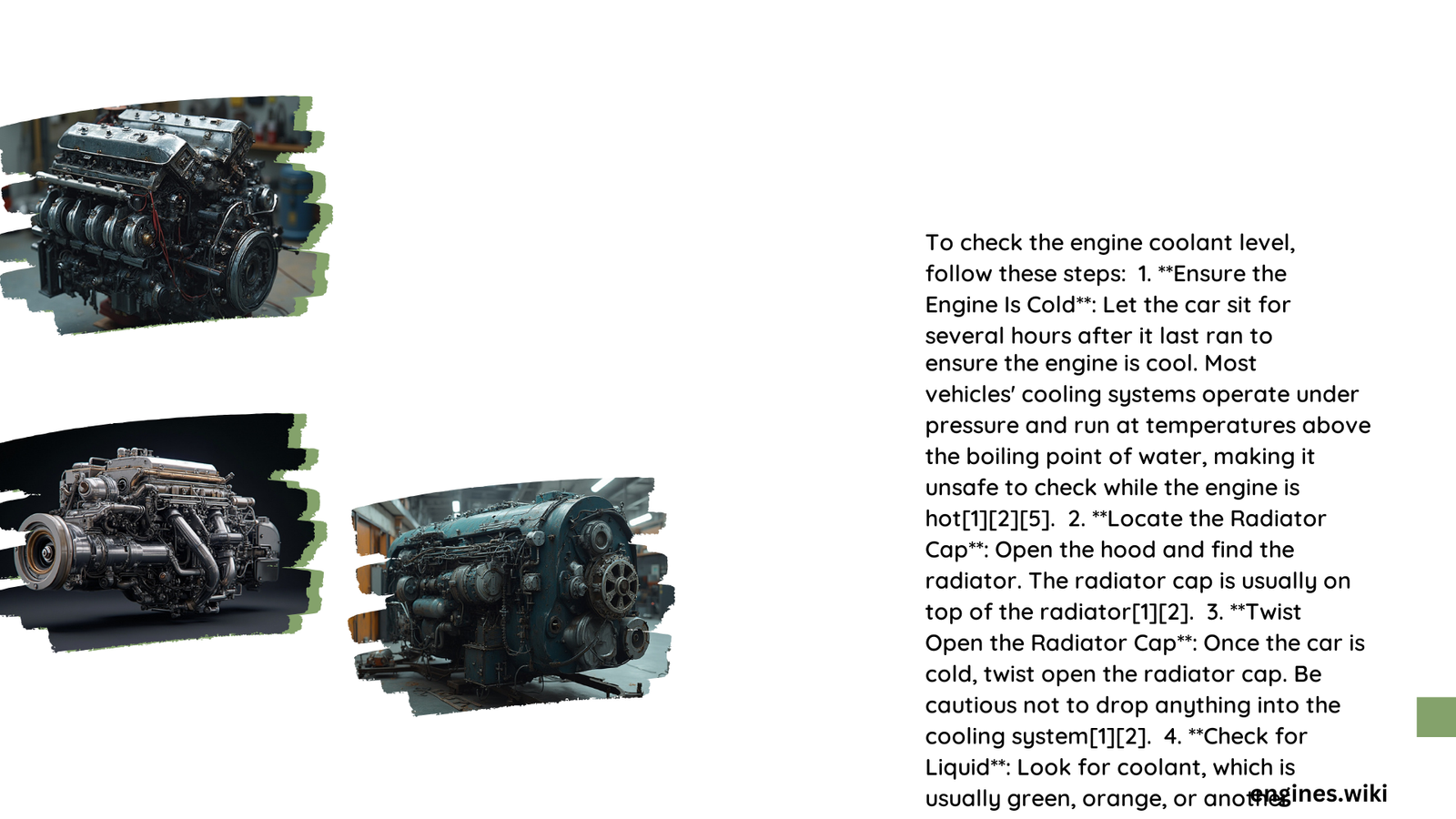Checking engine coolant levels is crucial for maintaining your vehicle’s health and performance. Whether the engine is hot or cold, proper coolant level inspection ensures optimal engine temperature regulation and prevents overheating. This guide provides comprehensive information on how to check coolant levels in both hot and cold engines, safety precautions, and best practices for maintaining proper coolant levels.
What Are the Key Differences Between Checking Coolant Levels in Hot vs. Cold Engines?
Checking coolant levels in hot and cold engines requires different approaches due to the expansion and contraction of coolant with temperature changes. Here’s a breakdown of the key differences:
Hot Engine Coolant Check:
- Wait 30-60 minutes after turning off the engine
- Coolant expands when hot, so levels may appear higher
- Use caution when opening the radiator cap to avoid burns
- Check the overflow tank first for safety
Cold Engine Coolant Check:
- Perform after the engine has been off for several hours or overnight
- Coolant is at its most condensed state
- Safe to open the radiator cap without risk of burns
- More accurate representation of true coolant level
How to Safely Check Coolant Levels in a Hot Engine?

- Park the vehicle on level ground and turn off the engine
- Wait 30-60 minutes for the engine to cool down partially
- Locate the coolant overflow tank (usually a clear plastic container)
- Check the coolant level against the ‘Hot’ or ‘Max’ markings
- If needed, carefully open the radiator cap using a thick cloth
- Verify the coolant level is at the bottom of the filler neck
Safety Tip: Never open a hot radiator cap immediately after driving, as it can cause severe burns from pressurized, hot coolant spray.
What’s the Proper Method for Checking Coolant in a Cold Engine?
- Ensure the engine is completely cool (typically after being off overnight)
- Locate the coolant overflow tank
- Check the coolant level against the ‘Cold’ or ‘Min’ markings
- If necessary, remove the radiator cap
- Verify the coolant level reaches the bottom of the filler neck
- Add coolant if the level is below the recommended marks
Note: Always use the type of coolant specified in your vehicle’s owner manual.
What Are the Ideal Coolant Level Indicators for Both Hot and Cold Engines?
| Engine State | Overflow Tank | Radiator |
|---|---|---|
| Hot | Between ‘Hot’ and ‘Full’ marks | At bottom of filler neck |
| Cold | Between ‘Cold’ and ‘Full’ marks | At bottom of filler neck |
It’s important to note that these indicators may vary slightly depending on the vehicle make and model. Always consult your owner’s manual for specific guidelines.
How Often Should You Check Engine Coolant Levels?
Regular coolant level checks are essential for maintaining your vehicle’s health. Here’s a recommended schedule:
- Every oil change (typically every 3,000-5,000 miles)
- Before long trips
- At the change of seasons (especially before summer and winter)
- If you notice any coolant-related warning lights on your dashboard
What Are Common Signs of Low Coolant Levels?
- Engine overheating
- Sweet smell from the engine bay
- Coolant warning light on the dashboard
- White exhaust smoke
- Decreased fuel efficiency
If you notice any of these signs, check your coolant levels immediately and top up if necessary.
How to Top Up Coolant Safely?
- Ensure the engine is cool
- Locate the coolant reservoir
- Remove the cap carefully
- Add a 50/50 mix of antifreeze and distilled water
- Fill to the ‘Full’ or ‘Max’ line
- Replace the cap securely
- Start the engine to check for leaks
Important: Never add coolant to a hot engine, as it can cause thermal shock and damage engine components.
What Safety Precautions Should You Take When Checking Coolant Levels?
- Wear protective gloves and eyewear
- Ensure the engine is sufficiently cooled
- Use a thick cloth when opening the radiator cap
- Work in a well-ventilated area
- Keep coolant away from children and pets (it’s toxic if ingested)
- Clean up any spills immediately
How Can You Identify Coolant Issues Beyond Low Levels?
While checking coolant levels, also inspect for:
- Unusual colors (should be green, orange, or pink depending on the type)
- Particles or debris in the coolant
- Oily film on the surface (indicates possible oil leak into the cooling system)
- Strong, sweet smell (may indicate a coolant leak)
If you notice any of these issues, consult a professional mechanic for a thorough inspection.
By following these guidelines for checking engine coolant levels in both hot and cold conditions, you can help ensure your vehicle’s cooling system functions optimally, preventing overheating and potential engine damage.
References:
1. AutoZone – How to Check Your Coolant Level
2. Cars.com – How to Check Your Car’s Engine Coolant
3. CarParts.com – Coolant Temperature Warning Light: Meaning, Causes, What to Do
